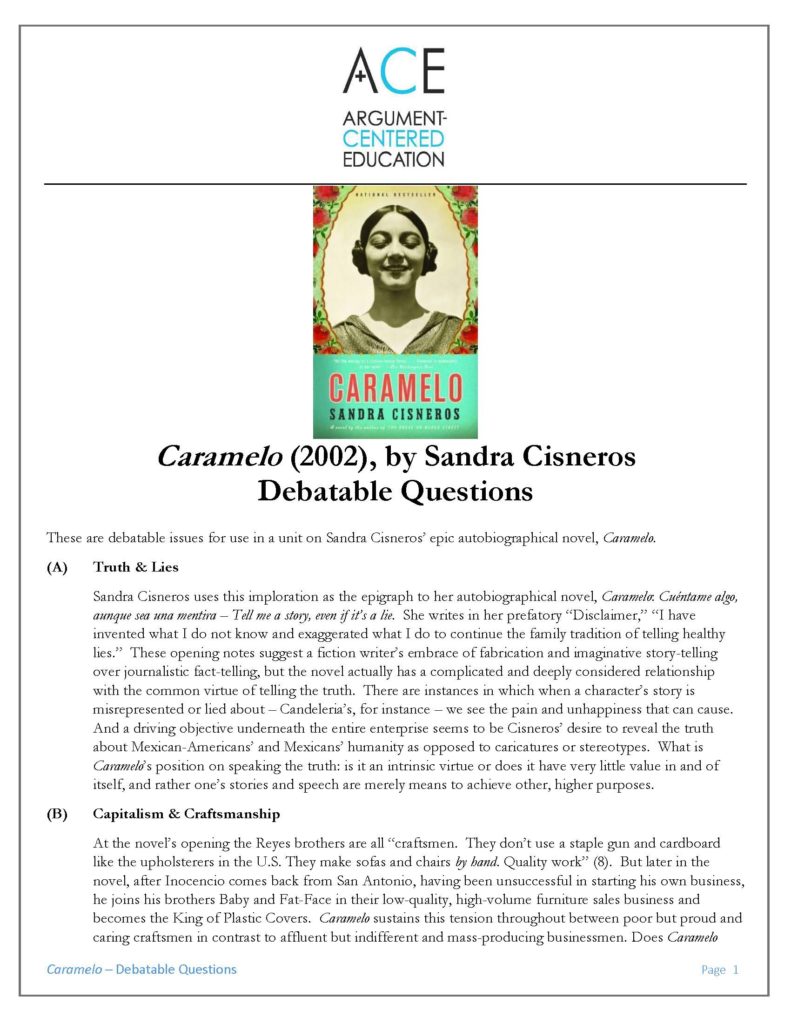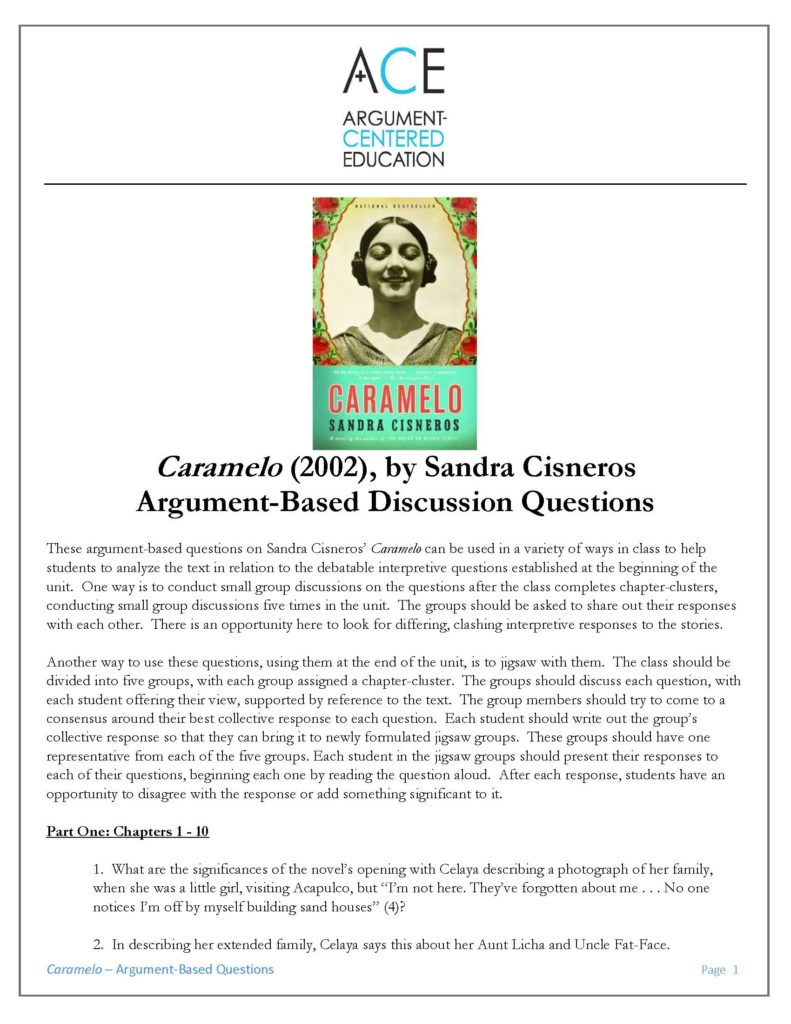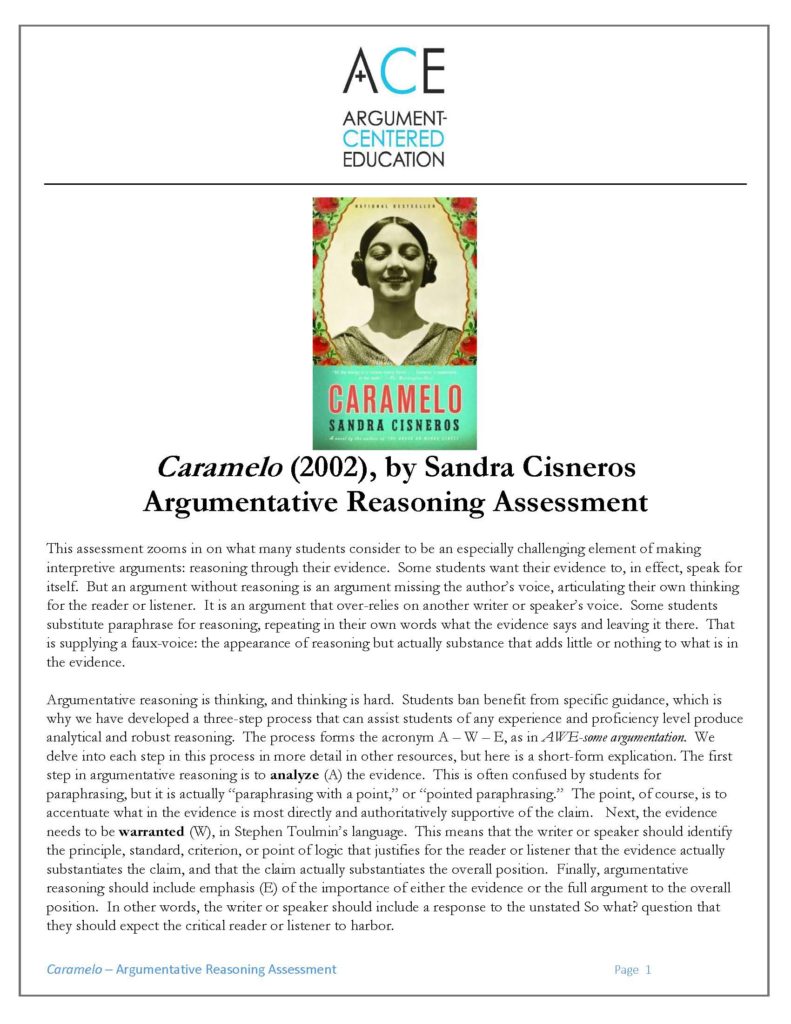
AWE-some Reasoning Through Interpretive Arguments on ‘Caramelo’
Sandra Cisneros is a staple in high school and middle school reading lists, but not for Caramelo. The House on Mango Street (1984), Cisneros’ short and powerful story collection, is well known and well loved for good reasons. One of them is its austere, rather journalistic and plain-spoken prose style. Caramelo is its very under-read and under-assigned opposite in many ways. This 2002 epic novel tells the multi-generational story of the Mexican-American Reyes family, through the eyes of its adolescent, sensitive, wry protagonist, Ceyla Reyes. Despite its 500+ page length, it is very well worth looking into as an engaging achievement of Latino literature, workable in many high school English reading lists.
This past spring I worked with a partner school’s English department to argumentalize its Caramelo unit, focusing on argumentative reasoning in writing and speaking.
We began of course with a set of debatable issues, collaboratively constructed with teachers, students, and my thinking and formulations.

We also worked on fully-aligned argument-based questions, distributed based on chapter clusters on this rather long novel.
These argument-based questions on Sandra Cisneros’ Caramelo can be used in a variety of ways in class to help students to analyze the text in relation to the debatable interpretive questions established at the beginning of the unit. One way is to conduct small group discussions on the questions after the class completes chapter-clusters, conducting small group discussions five times in the unit. The groups should be asked to share out their responses with each other. There is an opportunity here to look for differing, clashing interpretive responses to the stories.
Another way to use these questions, using them at the end of the unit, is to jigsaw with them. The class should be divided into five groups, with each group assigned a chapter-cluster. The groups should discuss each question, with each student offering their view, supported by reference to the text. The group members should try to come to a consensus around their best collective response to each question. Each student should write out the group’s collective response so that they can bring it to newly formulated jigsaw groups. These groups should have one representative from each of the five groups. Each student in the jigsaw groups should present their responses to each of their questions, beginning each one by reading the question aloud. After each response, students have an opportunity to disagree with the response or add something significant to it.

And the culmination of this unit: the argumentative reasoning assessment. This assessment zooms in on what many students consider to be an especially challenging element of making interpretive arguments: reasoning through their evidence. Some students want their evidence to, in effect, speak for itself. But an argument without reasoning is an argument missing the author’s voice, articulating their own thinking for the reader or listener. It is an argument that over-relies on another writer or speaker’s voice. Some students substitute paraphrase for reasoning, repeating in their own words what the evidence says and leaving it there. That is supplying a faux-voice: the appearance of reasoning but actually substance that adds little or nothing to what is in the evidence.
Argumentative reasoning is thinking, and thinking is hard. Students ban benefit from specific guidance, which is why we have developed a three-step process that can assist students of any experience and proficiency level produce analytical and robust reasoning. The process forms the acronym A – W – E, as in AWE-some argumentation. We delve into each step in this process in more detail in other resources, but here is a short-form explication. The first step in argumentative reasoning is to analyze (A) the evidence. This is often confused by students for paraphrasing, but it is actually “paraphrasing with a point,” or “pointed paraphrasing.” The point, of course, is to accentuate what in the evidence is most directly and authoritatively supportive of the claim. Next, the evidence needs to be warranted (W), in Stephen Toulmin’s language. This means that the writer or speaker should identify the principle, standard, criterion, or point of logic that justifies for the reader or listener that the evidence actually substantiates the claim, and that the claim actually substantiates the overall position. Finally, argumentative reasoning should include emphasis (E) of the importance of either the evidence or the full argument to the overall position. In other words, the writer or speaker should include a response to the unstated So what? question that they should expect the critical reader or listener to harbor.
For this assessment, students should study the model interpretive argument closely, then you should complete the interpretive arguments below, using the three-step, A – W – E process, so that you can produce AWE-some argumentation. All of the arguments align with the debatable issues that have been in use in this unit on Cisneros’ Caramelo. And for each argument students are to complete they are being given their interpretive position, the argumentative claim that develops it, and the textual evidence supportive of the claim. Their work is all about the argumentative reasoning.


